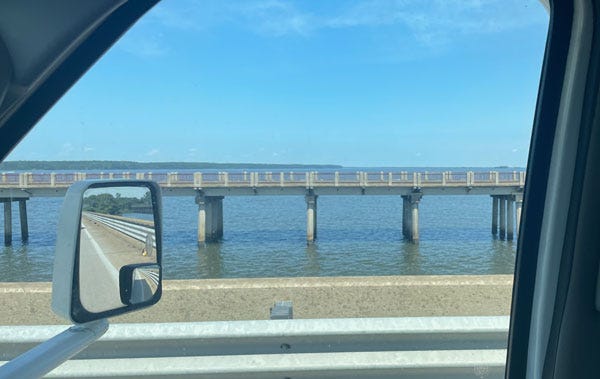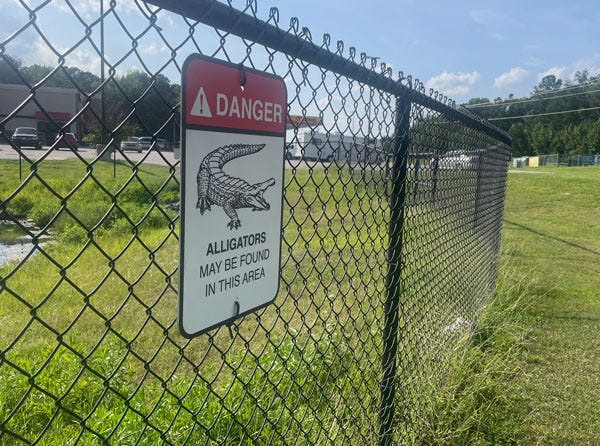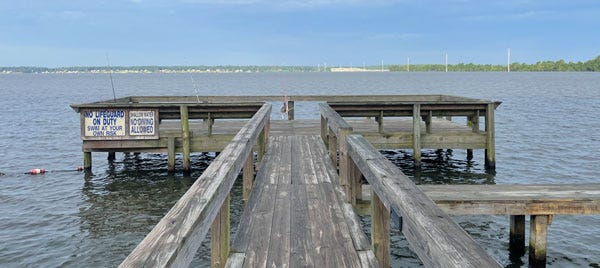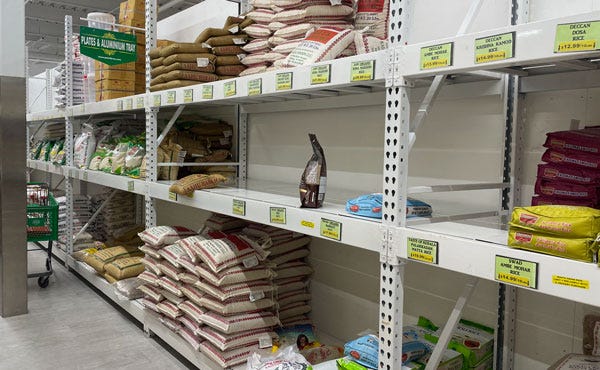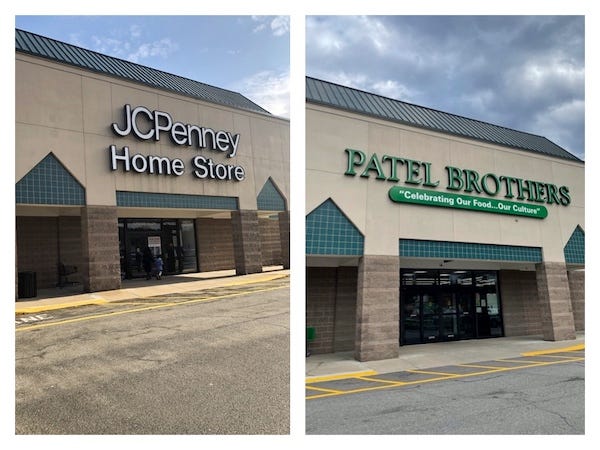Wednesday Walk: Alligator Feed
Watching where we swim, a fresh look at Wal-Mart, and where's all the rice?
Welcome to Willoughby Hills!
If you enjoy what you’re reading, please consider a free subscribtion to receive emails every Wednesday and Sunday plus podcast episodes every two weeks. There are also paid options, which unlock even more features.
As is typical every Wednesday, I’m bring you a smattering of topics that I hope will make you a bit more curious about the world around you and give you something to think about later. I call these Wednesday Walks, as it’s the type of conversation we might have walking down a path in the woods. Shall we take a stroll?
I’m Not From Around Here
We are finally home after many, many days on the road in our RV. I’m planning to write some deeper reflections on RV travel later, but today, I wanted to share one little anecdote.
Because so much of the country has been gripped in heat waves, we wanted to stay at a campground where we could run our air conditioner on the drive home. As I was driving, my wife looked up KOA locations along I-95 and found a campground in Summerton, SC known as Santee Lakes KOA Journey.
I immediately knew the campground and it seemed worth a stop. I remembered seeing a billboard for it on our drive south and it had the perfect setting. It was just off the interstate, but was also on the shores of Lake Marion, the largest lake in South Carolina.
I always love this stretch of I-95. Even though it’s an inland lake, it’s one of the first times on the drive South where it feels like you’re getting to the swampier coastal estuaries that make up South Carolina, Georgia, and Florida closer to the shoreline. There’s also a bridge that runs parallel to the interstate that is currently closed but is being restored for pedestrian and bicycle use. (It’s one of the bridges that inspired something I wrote last year).
We pulled into the campground in the early evening just before sunset and made our way down to the beach to stretch our legs after a long day of travel. There were some folks swimming, so we decided to wade in to the lake a bit. It was so refreshing to squeeze my toes into cool water and sandy bottom. My kids loved it. Even my dog was splashing.
Then it occurred to my wife and I nearly simultaneously: we were in the South in a freshwater body of water. At dusk.
We both had flashbacks to the young boy that was killed when an alligator attacked him at Walt Disney World in 2016. At the time, it sounded like it was a freakish combination of the boy wading into a lake at dusk (when alligators hunt for prey) and his size being similar to a small animal which led to the attack. Here we were in the water at sunset, with a small animal (our dog), and our kids. As soon as the possible implications of what we were doing became clear, we got out of the water- and fast!
Looking later, we learned that not only were there alligators in Lake Marion, but it’s considered the most alligator infested body of water in South Carolina! Unbeknownst to us, a woman was killed in an alligator attack earlier this month on Hilton Head Island while walking her dog.
Earlier that day, I was struck by an alligator warning sign near a fenced in retention pond at a Love’s truck stop where I was walking my dog. It stood out to me so much that I photographed it.
Strangely, the only sign that we saw at the beach was “Swim at Your Own Risk,” which is commonplace at any beach or pool where there’s no lifeguard on duty. Perhaps Southerners are more used to the hazards of alligators? Maybe there’s a New England danger that outsiders would find scary but we learn to live with, but to us, dipping our toes in the water was an idea we instantly regretted.
The campground was beautiful, but I’m not sure it’s one we’re eager to return to anytime soon. If we do, we’ll likely be staying a few feet back from the shore, especially at sunset.
Wal-Mart U.S.A.
I’ve been a fan of
for a while now, often quoting from his amazing daily newsletter . Today, I wanted to share another piece from Del Mastro which was recently published in Discourse Magazine.The article, titled “Walmart Didn’t Kill the Small Town, It Is the Small Town” is a succinct and comprehensive summation of a thread that he’s pulled at before- that a Wal-Mart store, perhaps somewhat ironically, actually resembles a classic Main Street on the inside. There’s the grocer, the toy store, the clothing store, even the pet store- they just all happen to be under a single roof and run by an international conglomerate.
It’s an interesting idea and a unique take on the big box format to be sure. Del Mastro argues that one of the big improvements that Wal-Mart brings to the table is its walkability for pedestrians:
“We might argue over whether big-box retail represents efficiency and progress, or concentration of economic power. Perhaps it is both. But almost everybody agrees that a store like Walmart is cheap and convenient, compared to the old model of going into town and patronizing a number of distinct and separate enterprises.”
This can be said for suburban shopping malls too, which remove the car from the commercial environment, but malls often did so with intentional design meant to elevate the form of Main Street. Fountains, skylights, indoor trees- they all were placed in shopping malls intentionally as placemaking. But Del Mastro sees Wal-Mart as a truly stripped down, maybe even more pure form of all of this.
His article is worth reading as it’s truly a unique take on a familiar form (and if you’re not already, please go subscribe to
).I wrote a few months ago about stumbling upon a Wal-Mart that resembled a block of Main Street stores from the outside, but I hadn’t considered how much Wal-Mart also resembles Main Street from inside.
Empty Aisles
Finally today, I wanted to share a little story about grains and global shortages.
I recently stopped into the Patel Brothers supermarket in Nashua, NH to buy some rice. This store usually has an entire aisle of bulk rices, all at very good prices. But here’s what the typically brimming aisle in Patel Brothers looked like on my recent visit.
The aisle was maybe stocked to about 50%, with many styles of rice being completely sold out. What was going on?
It turns out that there’s a worldwide rice shortage at the moment, planned to be the worst one in two decades. As with many of these supply chain issues over the last few years, there doesn’t seem to be a single culprit, but several. The war in Ukraine drove higher consumption of rice as other grains from Russia become more expensive. A heavy monsoon season in China and Pakistan wiped out much of the crop. And rice production in the U.S. and E.U. was lower than expected last year.
India recently banned the export of several types of rice to deal with the shortage. This has caused a bit of a panic in Indian ex-pat communities, who are buying rice now to stock up, anticipating that it could get worse before it gets better. Like toilet paper in early 2020, as more people panic buy, the shortages actually feel worse.
Ironically, it sounds like next year could be a banner year for rice production and the year will end with a surplus. Only time will tell, I suppose.
And one interesting bit of trivia about the changing face of retail which also plays into this story. A few years ago, the storefront that is now Patel Brothers was a JC Penney Home Store. They sold furniture, appliances, and smaller home furnishings like curtains and linens. I used to shop there on occasion.
JC Penney Home Store closed a few years ago and Patel Brothers moved into the space. Even though the supermarket has been around since 1974, it has been experiencing massive growth over the last few decades, with 54 stores currently operating in the U.S. and more on the horizon.
It’s not an everyday supermarket for us, but is definitely in our monthly rotation of places to visit. And we don’t miss a thing about the JC Penney Home Store.
What are your thoughts? Leave a comment below- I love hearing from you!
I publish new issues every Wednesday and Sunday. Sign up to always receive the latest issue and support my work:
Other Wednesday Walks
If you’ve missed past issues of this newsletter, they are available to read here.





